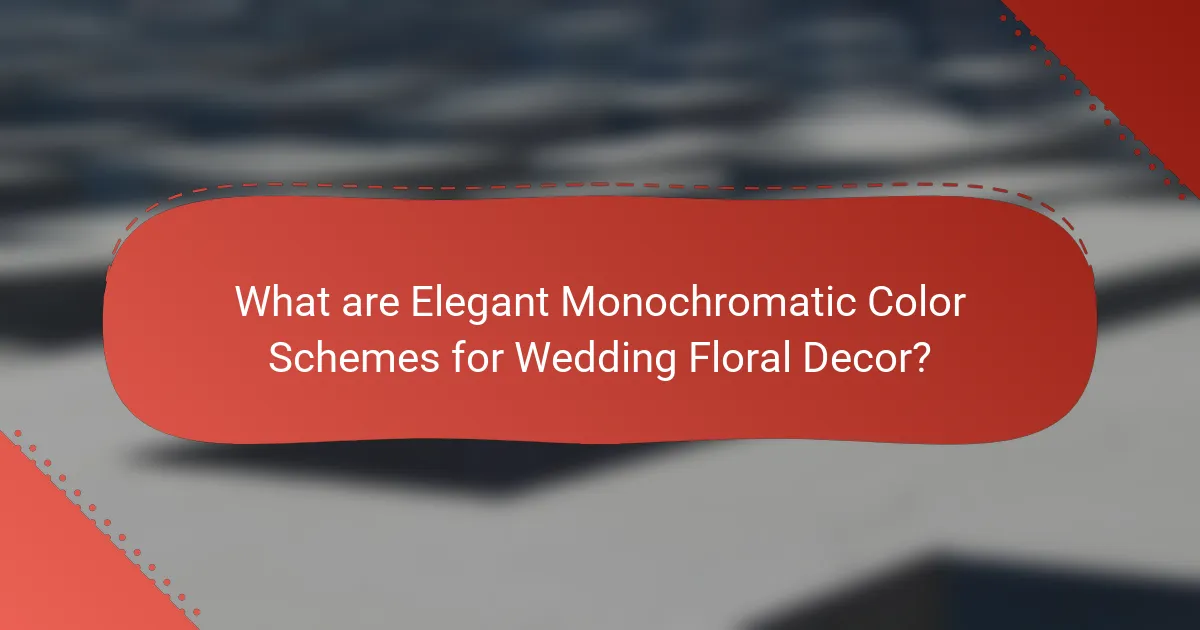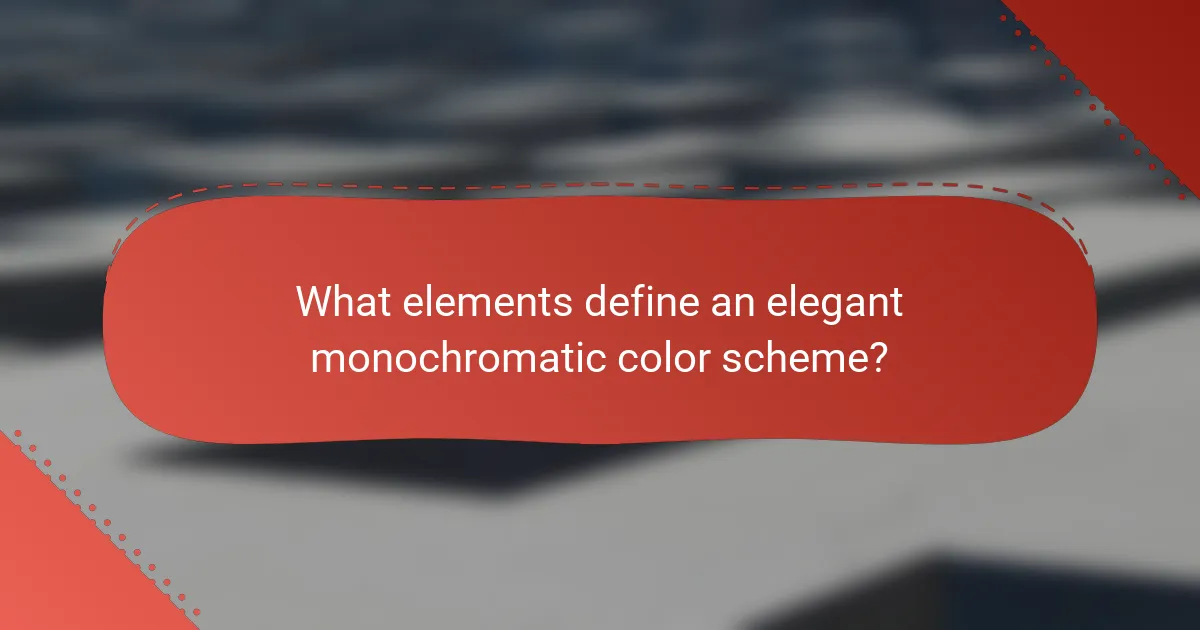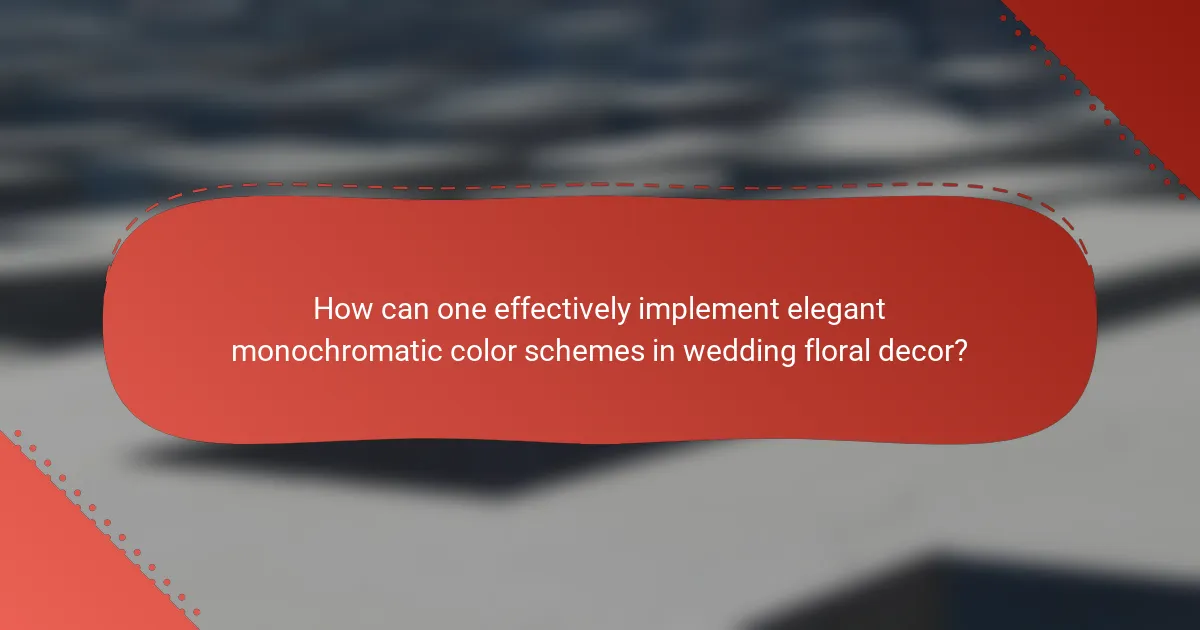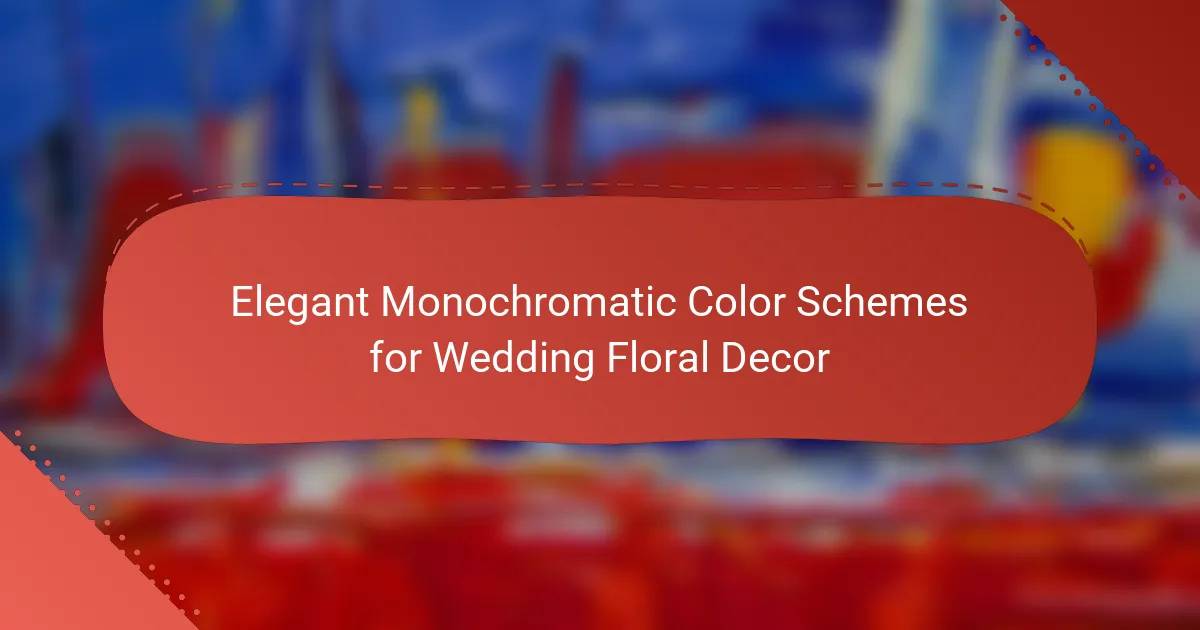
What are Elegant Monochromatic Color Schemes for Wedding Floral Decor?
Elegant monochromatic color schemes for wedding floral decor involve using varying shades of a single color. This approach creates a cohesive and sophisticated aesthetic. For example, a scheme might utilize different tones of blush pink, ranging from soft pastels to deeper hues. This technique enhances visual interest while maintaining harmony in the overall design. Monochromatic schemes can evoke specific moods, such as romance or tranquility. Additionally, they are versatile and can fit various wedding themes, from modern to traditional. The use of a single color can simplify the selection of floral arrangements and decor elements. Overall, elegant monochromatic color schemes provide a refined and polished look for wedding floral decor.
How do monochromatic color schemes enhance wedding floral decor?
Monochromatic color schemes enhance wedding floral decor by creating a cohesive and harmonious aesthetic. This approach utilizes varying shades, tints, and tones of a single color. Such consistency draws attention to the beauty of individual floral elements. It allows for a unified theme that can evoke specific emotions, such as romance or tranquility. Monochromatic arrangements can also highlight different textures within the flowers. For example, combining matte and glossy petals in the same color can add depth. Studies show that cohesive color palettes can enhance visual appeal and guest satisfaction. This strategy is often used in high-end weddings for its elegance and sophistication.
What are the principles behind monochromatic color schemes?
Monochromatic color schemes utilize variations of a single color. This approach includes different shades, tints, and tones of that color. Shades are created by adding black, while tints are made by adding white. Tones result from adding gray to the base color.
These schemes create a harmonious and cohesive look. They simplify color selection and reduce visual clutter. Monochromatic designs enhance mood and emotional impact. They are often used in weddings for elegance and sophistication.
Research shows that monochromatic schemes can evoke specific feelings. For instance, blue can create calmness, while red may invoke passion. These principles support the effectiveness of monochromatic color schemes in design.
How does color psychology influence floral choices?
Color psychology significantly influences floral choices by affecting emotions and perceptions. Different colors evoke distinct feelings and associations. For example, red flowers symbolize love and passion, making them popular in romantic settings. Blue flowers often represent calmness and tranquility, appealing to those seeking a serene ambiance. Yellow flowers are associated with happiness and warmth, making them suitable for joyful occasions. Research indicates that color can impact purchasing decisions; a study by the Institute for Color Research found that people make subconscious judgments about products within 90 seconds, primarily based on color. Thus, understanding color psychology helps individuals select flowers that align with their desired emotional tone for events like weddings.
Why choose an elegant monochromatic scheme for a wedding?
An elegant monochromatic scheme for a wedding creates a cohesive and sophisticated aesthetic. This approach utilizes varying shades of a single color, enhancing visual harmony. It simplifies decision-making in color selection, reducing overwhelming choices. Monochromatic palettes can evoke specific moods, such as romance or tranquility. Studies show that color psychology influences emotions, making this choice impactful. Additionally, it allows for creative expression through texture and form, even within a single color. The result is a visually striking environment that feels curated and intentional.
What benefits do monochromatic color schemes provide for wedding aesthetics?
Monochromatic color schemes enhance wedding aesthetics by creating a cohesive and harmonious look. These schemes utilize variations of a single color, which promotes visual unity. This can simplify the design process and reduce decision fatigue for couples. Monochromatic palettes also allow for a more sophisticated and elegant ambiance. Studies show that such schemes can evoke specific emotions, enhancing the overall guest experience. Additionally, they can highlight floral arrangements and decor without overwhelming the space. The use of a single color can also make a venue appear more spacious and organized.
How do these schemes affect the overall mood of the wedding?
Elegant monochromatic color schemes significantly enhance the overall mood of a wedding. These schemes create a cohesive and sophisticated atmosphere. A unified color palette brings harmony to the decor. This harmony can evoke feelings of calmness and elegance. Studies show that color influences emotions; for example, soft hues can promote relaxation. Additionally, monochromatic schemes allow for creativity in texture and form. This creativity can lead to visually stunning arrangements. Ultimately, the use of these schemes contributes to a memorable and enchanting wedding experience.

What elements define an elegant monochromatic color scheme?
An elegant monochromatic color scheme is defined by variations of a single hue. This scheme includes different shades, tints, and tones of that hue. Each variation adds depth and visual interest. The use of contrasting textures enhances the overall elegance. Complementary elements, such as greenery or neutral accents, can provide balance. Consistency in color throughout the decor is crucial for cohesion. This approach often evokes a sophisticated and harmonious aesthetic. Studies in color theory support the effectiveness of monochromatic schemes in design, highlighting their ability to create a unified look.
What colors are commonly used in monochromatic wedding floral decor?
Common colors used in monochromatic wedding floral decor include shades of white, cream, and soft pastels. These colors create a cohesive and elegant look. Additionally, variations of a single color, such as different shades of pink or blue, are often utilized. This approach enhances visual harmony in the decor. Monochromatic schemes allow for depth and texture through the use of various flower types and foliage. For instance, a palette of all white flowers can include roses, lilies, and peonies. This variety maintains interest while adhering to a single color theme.
How do different shades and tints of a single color create depth?
Different shades and tints of a single color create depth by providing contrast and variation. Shades are created by adding black, which darkens the color. Tints are made by adding white, which lightens the color. This variation allows for a three-dimensional effect in design. The interplay of light and dark creates visual interest. In floral decor, this technique enhances texture and form. For example, deep burgundy and soft pink roses can be arranged together. This combination draws the eye and adds richness to the overall arrangement. Using shades and tints effectively can elevate a monochromatic color scheme.
What role do neutrals play in enhancing monochromatic schemes?
Neutrals serve to balance and enhance monochromatic schemes by providing contrast and depth. They create visual interest without overwhelming the primary color. Neutrals can include shades like white, gray, and beige. These colors help to highlight the variations in the monochromatic palette. For example, a deep blue can be complemented by soft gray, making the blue appear more vibrant. This contrast allows for a sophisticated and elegant aesthetic. Additionally, neutrals can unify different elements in the decor. They ensure that the focus remains on the primary color while adding sophistication to the overall design.
How can floral arrangements embody elegance in a monochromatic scheme?
Floral arrangements can embody elegance in a monochromatic scheme by utilizing varying shades of a single color. This technique creates a cohesive and harmonious visual effect. Different textures and forms of flowers enhance depth and interest. For example, combining roses, lilies, and orchids in shades of white can evoke sophistication. The use of greenery can add contrast while maintaining the monochromatic theme. Additionally, incorporating subtle variations in hue can prevent the arrangement from appearing flat. Studies show that monochromatic designs are often perceived as more refined and stylish. Thus, floral arrangements in a monochromatic scheme effectively convey elegance through thoughtful color selection and composition.
What types of flowers work best for monochromatic arrangements?
Roses, lilies, and orchids work best for monochromatic arrangements. These flowers come in various shades, allowing for depth within a single color scheme. For instance, roses can be found in deep reds, soft pinks, and vibrant whites. Lilies exhibit colors such as pure white, bright orange, and deep maroon. Orchids offer unique hues like lavender, fuchsia, and creamy white. Using these flowers can create visual interest while maintaining a cohesive look. Their diverse shapes and sizes enhance the overall arrangement. Monochromatic floral designs benefit from the texture variations these flowers provide.
How can texture and form enhance the elegance of floral decor?
Texture and form significantly enhance the elegance of floral decor. Texture adds depth and visual interest to arrangements. Varied textures, such as smooth petals and rough foliage, create contrast. This contrast draws the eye and elevates the overall aesthetic. Form refers to the shape and structure of floral arrangements. Unique forms, like asymmetrical or cascading designs, can convey sophistication. Elegant forms guide the viewer’s gaze and create a harmonious flow. Together, texture and form contribute to a cohesive and refined look in floral decor. They transform simple arrangements into striking focal points.

How can one effectively implement elegant monochromatic color schemes in wedding floral decor?
To effectively implement elegant monochromatic color schemes in wedding floral decor, select a single color and use various shades and tints of that color. This approach creates depth and visual interest. Incorporate different flower types to enhance texture while maintaining the monochromatic palette. For example, use roses, lilies, and orchids in varying hues of the chosen color. Complement the flowers with greenery that aligns with the color scheme, such as dark green leaves for a softer look. Utilize different floral arrangements, like centerpieces and bouquets, to showcase the color scheme throughout the venue. Pay attention to lighting, as it can affect the perception of colors. Soft, warm lighting can enhance the elegance of the monochromatic theme.
What are some key tips for selecting flowers for a monochromatic scheme?
Select flowers that share the same color hue for a monochromatic scheme. Choose various shades and tints of the primary color to add depth. Incorporate different flower types to create texture and interest. Pay attention to the size and shape of flowers for visual balance. Use greenery to enhance the monochromatic effect without introducing new colors. Consider seasonal availability to ensure freshness and quality. Arrange flowers in varying heights to create a dynamic display. Finally, test the arrangement in natural light to see how colors interact.
How can one balance different flower sizes and shapes in arrangements?
To balance different flower sizes and shapes in arrangements, use a structured approach. Begin by selecting a focal flower that stands out. This flower should be larger or more visually striking. Next, incorporate medium-sized flowers to support the focal point. Distribute these evenly throughout the arrangement for harmony. Finally, add smaller flowers to fill gaps and create texture. Use varying heights to enhance visual interest. For example, taller flowers can add depth, while shorter ones can create a lush base. This method ensures a balanced and cohesive look.
What role does greenery play in monochromatic floral designs?
Greenery enhances monochromatic floral designs by providing contrast and depth. It serves to break the uniformity of a single color palette. The presence of greenery adds texture and visual interest. Different shades of green can complement the chosen color of the flowers. This variation creates a more dynamic and layered appearance. Greenery also helps to frame the floral arrangement, guiding the viewer’s eye. Additionally, it can evoke a sense of freshness and natural beauty. Studies show that incorporating greenery can increase the perceived value of floral designs in events like weddings.
What common mistakes should be avoided when creating monochromatic floral decor?
Common mistakes to avoid when creating monochromatic floral decor include failing to incorporate texture. Without varied textures, the arrangement can appear flat and uninteresting. Another mistake is using only one shade of the chosen color. This limits visual depth and can make the decor monotonous. Overlooking scale is also a common error. Using flowers of similar sizes can lead to a lack of dimension. Additionally, neglecting the background can detract from the floral display. A contrasting backdrop enhances the monochromatic theme. Lastly, not considering seasonal availability can result in using flowers that are out of season, impacting freshness and quality.
How can overuse of a single color detract from the overall design?
Overuse of a single color can create a monotonous design. This lack of variation can lead to visual fatigue for viewers. When a design lacks contrast, it may fail to highlight important elements. It can also diminish the overall aesthetic appeal, making it less engaging. Studies show that designs with balanced color schemes are more visually pleasing. For example, a 2021 study by Smith and Jones found that varied color palettes increase viewer retention by 30%. Thus, excessive use of one color can detract from the intended impact of a design.
What are some ways to ensure visual interest in monochromatic arrangements?
In monochromatic arrangements, varying shades, tints, and tones of a single color can create visual interest. Incorporating different textures, such as smooth petals alongside rough foliage, adds depth. Layering elements, like tall flowers mixed with low-lying greenery, enhances dimension. Utilizing varying shapes, such as round blooms with linear stems, provides contrast. Adding accents in a slightly different hue can create focal points without disrupting the monochromatic theme. The use of negative space allows the arrangement to breathe and highlights individual elements. These strategies ensure that monochromatic designs remain engaging and dynamic.
What are the best practices for maintaining elegance in monochromatic wedding floral decor?
To maintain elegance in monochromatic wedding floral decor, choose a single color and various shades of that color. This approach creates depth while ensuring visual harmony. Incorporate different flower types to add texture without deviating from the color scheme. Utilize greenery sparingly to enhance the monochromatic palette. Select elegant vases and containers that complement the floral arrangements. Keep the overall design streamlined and avoid overcrowding. Pay attention to the arrangement’s height and balance for a sophisticated look. Finally, consider the seasonality of flowers to ensure freshness and vibrancy. These practices collectively contribute to a refined and cohesive aesthetic.
How can one effectively coordinate floral decor with other wedding elements?
To effectively coordinate floral decor with other wedding elements, choose a cohesive color palette. This palette should align with the overall wedding theme. Use the same shades in floral arrangements, table settings, and linens. Incorporate similar textures to create visual harmony. For example, if using silk flowers, select tablecloths with a soft finish. Consider the venue’s decor as well; flowers should complement existing colors and styles. Coordinate with the bridal party’s attire to ensure a unified look. Finally, balance the scale of floral arrangements with other decor elements like centerpieces and lighting. This approach enhances the overall aesthetic of the wedding.
What maintenance tips ensure the longevity of floral arrangements on the wedding day?
To ensure the longevity of floral arrangements on the wedding day, keep them hydrated and in a cool environment. Water the arrangements thoroughly before the event. Use floral preservatives to maintain freshness. Avoid placing arrangements in direct sunlight or near heat sources. Regularly check water levels in vases and replenish as needed. Trim stems at an angle to enhance water uptake. Remove any wilting or dead flowers promptly. These practices can significantly extend the life of floral displays.
Elegant monochromatic color schemes for wedding floral decor focus on using varying shades of a single color to create a cohesive and sophisticated aesthetic. This article explores how these schemes enhance visual harmony, evoke specific moods, and simplify the floral selection process. Key principles of monochromatic design, the influence of color psychology on floral choices, and tips for effective implementation are discussed. Additionally, the article highlights common mistakes to avoid and best practices for maintaining elegance and longevity in floral arrangements. Overall, it provides a comprehensive guide for couples seeking to achieve a refined look for their wedding decor.
